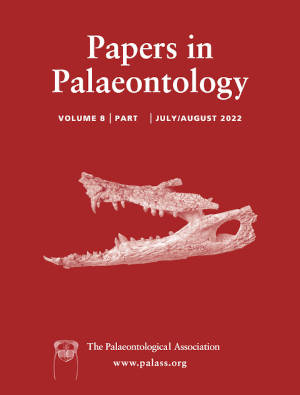Article: A new species of early Cambrian arthropod reconstructed from exceptionally preserved mandibles and associated small carbonaceous fossils (SCFs)
Publication: Papers in Palaeontology
Volume:
8
Part:
4
Publication Date:
2022
Article number:
e1458
Author(s):
Thomas H. P. Harvey, and Nicholas J. Butterfield
DOI:
10.1002/spp2.1458
Abstract
Abstract Mandibulate arthropods (myriapods, hexapods and crustaceans) account for a major component of extant animal diversity but their origins remain unclear. Here, we re-examine the record of exceptionally preserved arthropodan microfossils, including mandibles, from the lower Cambrian (Stage 4) Mount Clark Formation, Northwest Territories, Canada. The assemblage comes from a single drillcore horizon and occurs as thousands of small carbonaceous fossils (SCFs) representing disarticulated body parts. The mandibles occur as isolated molar surfaces with an elongate outline, a heavy setal fringe, and a subtle right–left asymmetry. These are sufficiently distinctive to diagnose a new genus and species of arthropod, Masticaris fimbriata. Co-occurring SCFs include diverse appendage lobes and ventral body fragments, along with spines and setae assignable to 53 morphological categories and occurring either singly or in arrays, including filter plates. Most are plausibly interpreted as belonging to the feeding apparatus of M. fimbriata. The mandibles and filter plates correspond to those in extant pancrustaceans, particularly branchiopods, although the mouthparts of some more basal Cambrian arthropods raise the possibility of convergent feeding adaptations. Overall, anatomical and taphonomic continuity with younger SCFs suggests that M. fimbriata belongs to an early pancrustacean radiation that is still largely cryptic in the fossil record. More generally, the assemblage provides an inventory of fine-scale cuticular specializations in early Cambrian arthropods that prefigure the trophic versatility and ecological dominance of crustaceans in the modern marine fauna.
